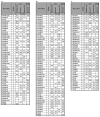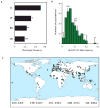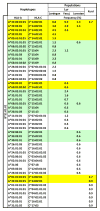HLA class I variation in Iranian Lur and Kurd populations: high haplotype and allotype diversity with an abundance of KIR ligands
- PMID: 27558013
- PMCID: PMC5063635
- DOI: 10.1111/tan.12852
HLA class I variation in Iranian Lur and Kurd populations: high haplotype and allotype diversity with an abundance of KIR ligands
Abstract
HLA-A, -B and -C alleles of 285 individuals, representing three Iranian Lur populations and one Iranian Kurd population were sequenced completely, yielding human leukocyte antigen (HLA) class I genotypes at high resolution and filling four fields of the official HLA nomenclature. Each population has 87-99 alleles, evenly distributed between the three HLA class I genes, 145 alleles being identified in total. These alleles were already known, named and deposited in the HLA database. The alleles form 316 different HLA A-B-C haplotypes, with each population having between 80 and 112 haplotypes. The four Iranian populations form a related group that is distinguished from other populations, including other Iranians. All four KIR ligands - the A3/11, Bw4, C1 and C2 epitopes - are well represented, particularly Bw4, which is carried by three high-frequency allotypes: HLA-A*24:02, HLA-A*32:01 and HLA-B*51:01. In the Lur and Kurd populations, between 82% and 94% of individuals have the Bw4 epitope, the ligand for KIR3DL1. HLA-B*51:01 is likely of Neandertal origin and associated with Behcet's disease, also known as the Silk Road disease. The Lordegan Lur have the highest frequency of HLA-B*51:01 in the world. This allele is present on 46 Lur and Kurd haplotypes. Present at lower frequency is HLA-B*51:08, which is also associated with Behcet's disease. In the four Iranian populations, 31 haplotypes encode both Bw4(+) HLA-A and Bw4(+) HLA-B, a dual combination of Bw4 epitopes that is relatively rare in other populations, worldwide. This study both demonstrates and emphasizes the value of studying HLA class I polymorphism at highest resolution in anthropologically well-defined populations.
Keywords: Bw4 epitope; HLA class I polymorphism; HLA-B*51:01; Lur and Kurd populations; high-throughput sequencing.
© 2016 John Wiley & Sons A/S. Published by John Wiley & Sons Ltd.
Conflict of interest statement
The authors have declared no conflicting interests.
Figures










Similar articles
-
KIR Variation in Iranians Combines High Haplotype and Allotype Diversity With an Abundance of Functional Inhibitory Receptors.Front Immunol. 2020 Apr 2;11:556. doi: 10.3389/fimmu.2020.00556. eCollection 2020. Front Immunol. 2020. PMID: 32300348 Free PMC article.
-
Distribution of HLA-A, -B, and -C alleles and HLA/KIR combinations in Han population in China.J Immunol Res. 2014;2014:565296. doi: 10.1155/2014/565296. Epub 2014 Jun 9. J Immunol Res. 2014. PMID: 24995346 Free PMC article.
-
KIR3DL1+HLA-B Bw4Ile80 and KIR2DS1+HLA-C2 combinations are both associated with ankylosing spondylitis in the Iranian population.Int J Immunogenet. 2011 Oct;38(5):403-9. doi: 10.1111/j.1744-313X.2011.01024.x. Epub 2011 Jul 29. Int J Immunogenet. 2011. PMID: 21797986
-
Associations between KIR epitope combinations expressed by HLA-B/-C haplotypes found in an HIV-1 infected study population may influence NK mediated immune responses.Mol Immunol. 2005 Feb;42(4):557-60. doi: 10.1016/j.molimm.2004.07.041. Mol Immunol. 2005. PMID: 15607813 Review.
-
KIR specificity and avidity of standard and unusual C1, C2, Bw4, Bw6 and A3/11 amino acid motifs at entire HLA:KIR interface between NK and target cells, the functional and evolutionary classification of HLA class I molecules.Int J Immunogenet. 2019 Aug;46(4):217-231. doi: 10.1111/iji.12433. Epub 2019 Jun 18. Int J Immunogenet. 2019. PMID: 31210416 Review.
Cited by
-
Genetic HLA Study of Kurds in Iraq, Iran and Tbilisi (Caucasus, Georgia): Relatedness and Medical Implications.PLoS One. 2017 Jan 23;12(1):e0169929. doi: 10.1371/journal.pone.0169929. eCollection 2017. PLoS One. 2017. PMID: 28114347 Free PMC article.
-
A genomic study on distribution of human leukocyte antigen (HLA)-A and HLA-B alleles in Lak population of Iran.Genom Data. 2016 Nov 10;11:3-6. doi: 10.1016/j.gdata.2016.11.012. eCollection 2017 Mar. Genom Data. 2016. PMID: 27900264 Free PMC article.
-
Sequences of 95 human MHC haplotypes reveal extreme coding variation in genes other than highly polymorphic HLA class I and II.Genome Res. 2017 May;27(5):813-823. doi: 10.1101/gr.213538.116. Epub 2017 Mar 30. Genome Res. 2017. PMID: 28360230 Free PMC article.
-
The association analysis between HLA-A*26 and Behçet's disease.Sci Rep. 2019 Mar 14;9(1):4426. doi: 10.1038/s41598-019-40824-y. Sci Rep. 2019. PMID: 30872678 Free PMC article.
-
KIR Variation in Iranians Combines High Haplotype and Allotype Diversity With an Abundance of Functional Inhibitory Receptors.Front Immunol. 2020 Apr 2;11:556. doi: 10.3389/fimmu.2020.00556. eCollection 2020. Front Immunol. 2020. PMID: 32300348 Free PMC article.
References
-
- Lahr MM, Foley RA. Towards a theory of modern human origins: geography, demography, and diversity in recent human evolution. Am J Phys Anthropol. 1998;(Suppl 27):137–76. - PubMed
-
- Cavalli-Sforza LL. The spread of agriculture and nomadic pastoralism: insights from the genetics, linguistics and archaeology. In: Harris DR, editor. The origins and spread of Agriculture and Pastoralism in Eurasia. London: University College London press; 1996. pp. 51–69.
-
- Hole F. Pastoral nomadism in Western Iran: Explorations in Ethnoarchaeology. University of New Mexico Press; 1978. pp. 127–167.
-
- Zvelebil M. The rise of the nomads in Central Asia. In: Sherratt A, editor. The Cambridge encyclopedia of archaeology. New York: Crown; 1980. pp. 252–256.
-
- Gunter MM. Historical Dictionary of the Kurds. 2. Scarecrow Press; 2011. p. 203.
MeSH terms
Substances
Grants and funding
LinkOut - more resources
Full Text Sources
Other Literature Sources
Research Materials
Miscellaneous

